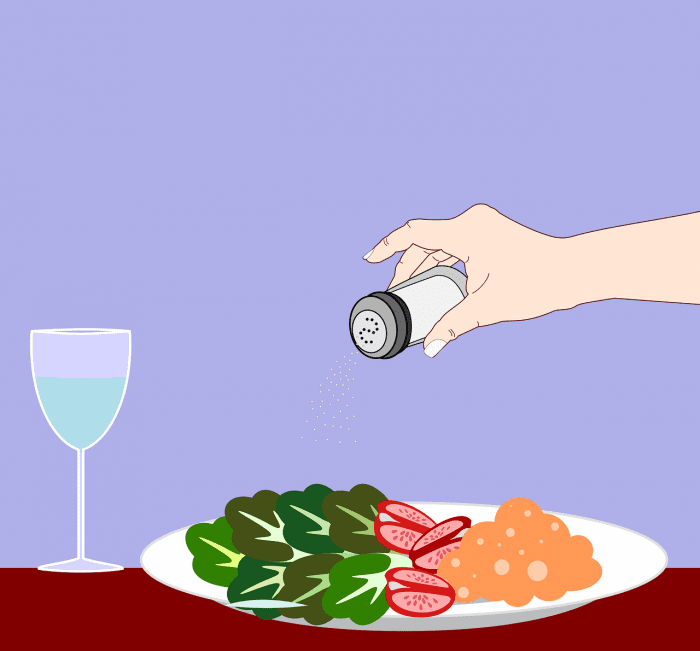Medical Compass: Winning the sodium war isn’t just about salt
Most Americans underconsume potassium
By David Dunaief, M.D.

Most of us know we need to lower our sodium intake. Still, more than 90 percent of us consume far too much sodium (1). Even if we don’t have hypertension, the impact of sodium on our health can be dramatic.
Sodium is insidious; it’s in foods that don’t even taste salty. Bread products are among the primary offenders. Other foods with substantial amounts of sodium include cold cuts and cured meats, cheeses, pizza, poultry, soups, pastas, sauces and, of course, snack foods. Processed foods and those prepared by restaurants are where most of our consumption occurs (2).
On the flip side, only about two percent of people get enough potassium from their diets (3).
Why is it important to reduce sodium and increase potassium? A high sodium-to-potassium ratio increases the risk of cardiovascular disease by 46 percent, according to the study, which looked at more than 12,000 Americans over almost 15 years (4). In addition, both may have significant impacts on blood pressure and cardiovascular disease.
To improve our overall health, we need to shift the sodium-to-potassium balance so that we consume more potassium and less sodium. And if you struggle with high blood pressure, this approach could help you win the battle. Let’s look at the evidence.
Why do we always harp on sodium?
Two studies illustrate the benefits of reducing sodium in high blood pressure and normotensive (normal blood pressure) patients, ultimately preventing cardiovascular disease, including heart disease and stroke.
The first used the prestigious Cochrane review to demonstrate that blood pressure is reduced by a significant mean of −4.18 mm Hg systolic (top number) and −2.06 mm Hg diastolic (bottom number) involving both normotensive and hypertensive participants (5). When looking solely at hypertensive patients, the reduction was even greater, with a systolic blood pressure reduction of −5.39 mm Hg and a diastolic blood pressure reduction of −2.82 mm Hg.
This was a meta-analysis (a group of studies) that evaluated data from 34 randomized clinical trials, totaling more than 3,200 participants. Salt reduction from 9 to 12 grams per day to 5 to 6 grams per day, determined using 24-hour urine tests, had a dramatic effect. The researchers believe there is a direct linear effect with salt reduction. In other words, the more we reduce the salt intake, the greater the effect of reducing blood pressure.
The authors recommend further reduction to 3 grams per day as a long-term target for the population and concluded that the effects on blood pressure will most likely result in a decrease in cardiovascular disease.
In the second study, a meta-analysis of 42 clinical trials, there was a similarly significant reduction in both systolic and diastolic blood pressures (6). This study included both adults and children. Both demographics saw a reduction in blood pressure, though the effect was greater in adults. Interestingly, an increase in sodium caused a 24 percent increased risk of stroke incidence but, more importantly, a 63 percent increased risk of stroke mortality. The risk of mortality from heart disease was increased alongside an increase in sodium, as well, by 32 percent.
In an epidemiology modeling study, the researchers projected that either a gradual or instantaneous reduction in sodium would save lives (7). For instance, a modest 40 percent reduction over 10 years in sodium consumed could prevent 280,000 premature deaths. These are only projections, but in combination with the above studies, they may be telling.
Why is potassium important?
When we think of blood pressure, not enough attention is given to potassium. The typical American diet doesn’t contain enough of this mineral.
In a meta-analysis involving 32 studies, results showed that as the amount of potassium was increased, systolic blood pressure decreased significantly (8). When foods containing 3.5 to 4.7 grams of potassium were consumed, there was an impressive −7.16 mm Hg reduction in systolic blood pressure with high blood pressure patients. Anything more than this amount of potassium did not have any additional benefit. Increased potassium intake also reduced the risk of stroke by 24 percent. This effect was important.
The reduction in blood pressure was greater with increased potassium consumption than with sodium restriction, although this was not a head-to-head comparison. The good news is that potassium is easily attainable in the diet. Foods that are potassium-rich include bananas, almonds, raisins, sweet potato and green leafy vegetables such as Swiss chard.
The bottom line: decrease your sodium intake by almost half and increase potassium intake from foods. Lowering sodium intake may have far-reaching benefits, and it is certainly achievable. First, consume less and give yourself a brief period to adapt — it takes about six weeks to retrain your taste buds, once you cut your sodium. You can also improve your odds by increasing your dietary potassium intake, which also has a substantial beneficial effect, striking a better sodium-to-potassium balance.
References:
(1) Am J Clin Nutr. 2012 Sep;96(3):647-657. (2) www.cdc.gov. (3) Am J Clin Nutr. 2012 Sep;96(3):647-657. (4) Arch Intern Med. 2011;171(13):1183-1191. (5) BMJ. 2013 Apr 3;346:f1325. (6) BMJ. 2013 Apr 3;346:f1326. (7) Hypertension. 2013; 61: 564-570. (8) BMJ. 2013; 346:f1378.
Dr. David Dunaief is a speaker, author and local lifestyle medicine physician focusing on the integration of medicine, nutrition, fitness and stress management. For further information, visit www.medicalcompassmd.com.







